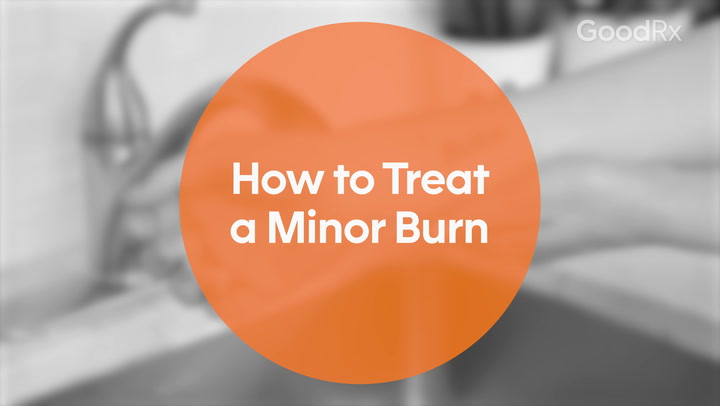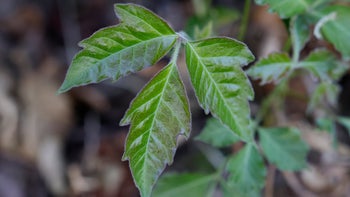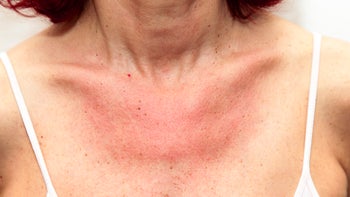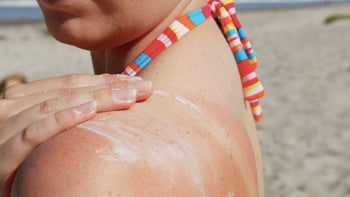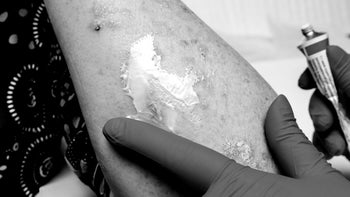
6 Ways to Get Rid of Poison Ivy Rash Symptoms Fast
Key takeaways:
Poison ivy rash is a painful, itchy rash caused by an allergic reaction to the oil found on poison ivy leaves.
There’s no way to get rid of poison ivy rash overnight, but treatments work fast to reduce discomfort.
Over-the-counter treatments that provide quick relief to poison ivy symptoms include cold compresses, calamine lotion, hydrocortisone cream, and oatmeal baths.
Table of contents

For many people, warm weather brings more time outside. But it can also bring itchy skin from bug bites, allergies, and poison ivy.
Poison ivy rash can be very uncomfortable, especially if it covers a large area of your body. And it can take weeks to go away completely. Unfortunately, there’s no way to get rid of a poison ivy rash immediately — but there are things you can do to help relieve the itch.
Here are six treatments that will relieve poison ivy symptoms fast.
Search and compare options
1. Calamine lotion
A lot of people have childhood memories of this bubblegum-colored lotion. Calamine lotion has been around for a long time because it works wonders to stop itching.
As it dries on the skin, it creates a cooling sensation that can quickly relieve itching. It also helps to dry out blisters and protect skin from further injury caused by scratching.
Here’s how to use calamine lotion for quick poison ivy symptom relief:
Wash your skin with warm water and gentle soap.
Pat the rash dry — don’t scrub.
Shake the bottle.
Use a cotton ball or clean cloth to dab calamine lotion over your rash.
Wait for the calamine lotion to dry.
You can use calamine lotion whenever you feel itchy.
Check the ingredients label on the calamine product before you buy it. Some brands of calamine lotion contain additional ingredients, like diphenhydramine (Benadryl). Combination products may not be suitable for people with certain medical conditions or young children.
2. Oatmeal baths
Oatmeal baths are another home remedy with a long history of treating itchy skin. A review by the FDA found that colloidal oatmeal is effective at relieving minor skin irritation and itching, including itchiness from poison ivy.
Which poison is it? Not sure if you have poison ivy, poison oak, or poison sumac? Our guide can help you spot the differences.
Steroid creams can relieve poison ivy symptoms. But you need to use the correct strength — here’s how to choose the right steroid cream.
Not sure how to make an oatmeal bath? Try our oatmeal bath recipe.
You can make an oatmeal bath at home using any uncooked, unflavored oatmeal. Grind about 1 cup into a fine powder, add it to a lukewarm bath, and bathe in the water for 15 minutes to help soothe poison ivy rash. You can also buy ready-to-use colloidal oatmeal bath packets at retail pharmacies and grocery stores.
You take an oatmeal bath whenever you feel itchy.
3. Diphenhydramine (Benadryl)
Diphenhydramine (Benadryl) is an over-the-counter (OTC) medication that helps relieve allergy symptoms, like itching. But it doesn’t work very well when it comes to itching from poison ivy rash.
Read more like this
Explore these related articles, suggested for readers like you.
Diphenhydramine (Benadryl) works by blocking histamine release. But the itchy rash caused by poison ivy isn’t caused by histamine release.
The sedating side effects of diphenhydramine, however, can be helpful when you’re trying to go to bed. People find that it’s easier to “ignore” the itching when they take diphenhydramine. The sedating side effects can help you fall asleep easier when you have a poison ivy rash.
Make sure to follow dosing instructions on the package. Avoid taking diphenhydramine during the daytime because it can make you sleepy.
4. Hydrocortisone cream
Hydrocortisone cream is a topical corticosteroid. It’s available OTC as a lotion or ointment. Steroid creams lower inflammation and swelling. This helps relieve itching and other poison ivy symptoms.
You can apply hydrocortisone cream to your rash up to 4 times a day for a week. Stopping steroid cream after a week can help you avoid side effects. Talk with a healthcare professional before using steroid creams on your face. Steroid creams can damage and thin the delicate skin on your face.
5. Cold compresses
Cold temperature can temporarily numb nerve endings in the skin, which will relieve itching. Try soaking a washcloth in cold water. Wring it out and gently apply to the skin for 15 to 20 minutes at a time. You can use a cool compress anytime you feel itchy.
You can use ice or a frozen pack instead of a cool compress. Just make sure to wrap it in a cloth before applying it to your skin. Ice or other frozen items can cause damage if directly applied to the skin.
Take a cool shower if you have a poison ivy rash over a large area. The cool water can also help relieve itchiness and swelling.
6. Burow’s solution
Burow’s solution is an OTC astringent that contains aluminum. It’s available under several brand names and can be found in most retail pharmacies. It can help keep your rash clean and dry when poison ivy blisters pop and start to weep.
Burow’s solution often comes in packets that you need to dissolve in cool water. You can then soak your rash in the solution for 15 to 30 minutes. You can also soak a clean cloth in the solution and then place the cloth over your rash.
You can use a Burow’s solution soak 3 to 4 times a day.
How can you stop poison ivy rash from spreading?
Poison ivy rash spreads when the oil from the plant touches your skin. The rash isn’t contagious. So once you get rid of all traces of the plant oil, the rash shouldn’t spread.
The oil from poison ivy can stick to the skin, under fingernails, on clothing and pet fur. To prevent a poison ivy rash from spreading:
Take off any clothes that may have touched the plant.
Wash your skin with soap and water. Repeat a few times.
Clean underneath your fingernails, where oil can become trapped.
Wash clothing and shoes before using again (and use gloves to handle until you do).
Bathe pets if they spend time outdoors near poison ivy.
When should you get medical care for poison ivy?
Most of the time, poison ivy rash can be treated at home. But there are some cases where it’s best to see a healthcare professional. Get medical care for poison ivy if:
The poison ivy rash is on your face or genitals.
The rash is over large areas of skin.
Itching isn’t relieved with at-home treatment.
You have other symptoms, like fevers, chills, difficulty breathing, nausea, or headache.
You may need to take oral steroids (by mouth) if the rash is very large or involves a sensitive area like the face, hands, feet, or groin. Oral steroids, like prednisone or methylprednisolone, are prescription medications that reduce swelling, itching, and redness from poison ivy rash.
You should also get medical care if you think the skin might be infected. Scratching itchy skin can introduce bacteria that cause infection. See your healthcare professional if the rash is getting worse or it has yellow or thick drainage (pus) coming from it.
Frequently asked questions
A helpful way to identify the poison ivy plant is the saying “leaves of three, let it be.” While poison ivy isn’t the only plant with three distinct leaves, this general rule of thumb lets you err on the side of caution. Poison ivy can grow as a climbing vine or spread low through grass. The leaves are shiny and green (though the color changes with the seasons), and the middle leaf is bigger than the other two.
If you’ve had poison ivy rash before, symptoms can start within a few hours of another exposure to urushiol. But if it’s your first time getting poison ivy, it can take a few days or even weeks for itchiness and redness to show up.
No, not everyone is allergic to poison ivy. But most people do have an allergic reaction when they come into contact with urushiol — the oil in poison ivy (along with poison oak and sumac) that causes an allergic reaction.
The bottom line
The rash from poison ivy can be itchy and uncomfortable. There’s no way to cure poison ivy rash immediately, but there are lots of ways to reduce symptoms and prevent the rash from spreading. OTC treatments like calamine lotion, colloidal oatmeal baths, and hydrocortisone cream are all proven remedies for treating poison ivy. Get medical care for serious cases of poison ivy, or if the rash is getting worse.
Why trust our experts?



References
American Academy of Dermatology Association. (n.d.). Poison ivy, oak, and sumac: How can I prevent a rash?
American Academy of Dermatology Association. (n.d.). Poison ivy, oak, and sumac: When does the rash appear?
Kim, Y., et al. (2019). Poison ivy, oak, and sumac dermatitis: What is known and what is new? Dermatitis.
Liu, B., et al. (2019). Cooling the Itch via TRPM8. Journal of Investigative Dermatology.
Marwa, K., et al. (2025). Type IV hypersensitivity reaction. StatPearls.
North Carolina State Extension. (n.d.). Poison ivy.
Pierson Laboratories. (2017). Calamine-calamine 8% and zinc oxide 8% lotion [package insert]. DailyMed.
Sharma, R., et al. (2017). Misuse of topical corticosteroids on facial skin. A study of 200 patients. Journal of Dermatological Case Reports.
Shuren, J. (2003). Skin protectant drug products for over-the-counter human use; final monograph. Federal Register.
TAGI Pharma. (2023). Astringent-calcium acetate monohydrate and aluminum sulfate tetradecahydrate powder, for solution [package insert]. DailyMed.
Trifecta Pharmaceuticals USA. (2025). Hydrocortisone 1%-hydrocortisone cream [package insert]. DailyMed.
U.S. Food and Drug Administration. (2021). Outsmarting poison ivy and other poisonous plants.
Usatine, R. P., et al. (2010). Diagnosis and management of contact dermatitis. American Family Physician.





